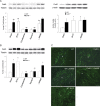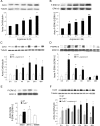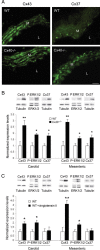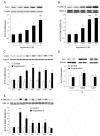An angiotensin II- and NF-kappaB-dependent mechanism increases connexin 43 in murine arteries targeted by renin-dependent hypertension
- PMID: 20110337
- PMCID: PMC2883896
- DOI: 10.1093/cvr/cvq031
An angiotensin II- and NF-kappaB-dependent mechanism increases connexin 43 in murine arteries targeted by renin-dependent hypertension
Abstract
Aims: Connexins (Cxs) play a role in the contractility of the aorta wall. We investigated how connexins of the endothelial cells (ECs; Cx37, Cx40) and smooth muscle cells (SMCs; Cx43, Cx45) of the aorta change during renin-dependent and -independent hypertension.
Methods and results: We subjected both wild-type (WT) mice and mice lacking Cx40 (Cx40(-/-)), to either a two-kidney, one-clip procedure or to N-nitro-l-arginine-methyl-ester treatment, which induce renin-dependent and -independent hypertension, respectively. All hypertensive mice featured a thickened aortic wall, increased levels of Cx37 and Cx45 in SMC, and of Cx40 in EC (except in Cx40(-/-) mice). Cx43 was up-regulated, with no effect on its S368 phosphorylation, only in the SMCs of renin-dependent models of hypertension. Blockade of the renin-angiotensin system of Cx40(-/-) mice normalized blood pressure and prevented both aortic thickening and Cx alterations. Ex vivo exposure of WT aortas, carotids, and mesenteric arteries to physiologically relevant levels of angiotensin II (AngII) increased the levels of Cx43, but not of other Cx. In the aortic SMC line of A7r5 cells, AngII activated kinase-dependent pathways and induced binding of the nuclear factor-kappa B (NF-kappaB) to the Cx43 gene promoter, increasing Cx43 expression.
Conclusion: In both large and small arteries, hypertension differently regulates Cx expression in SMC and EC layers. Cx43 is selectively increased in renin-dependent hypertension via an AngII activation of the extracellular signal-regulated kinase and NF-kappaB pathways.
Figures







References
-
- Haefliger JA, Nicod P, Meda P. Contribution of connexins to the function of the vascular wall. Cardiovasc Res. 2004;62:345–356. - PubMed
-
- Simon AM, McWhorter AR. Decreased intercellular dye-transfer and downregulation of non-ablated connexins in aortic endothelium deficient in connexin37 or connexin40. J Cell Sci. 2003;116:2223–2236. - PubMed
-
- Kruger O, Beny JL, Chabaud F, Traub O, Theis M, Brix K, et al. Altered dye diffusion and upregulation of connexin37 in mouse aortic endothelium deficient in connexin40. J Vasc Res. 2002;39:160–172. - PubMed
Publication types
MeSH terms
Substances
Grants and funding
LinkOut - more resources
Full Text Sources
Molecular Biology Databases

